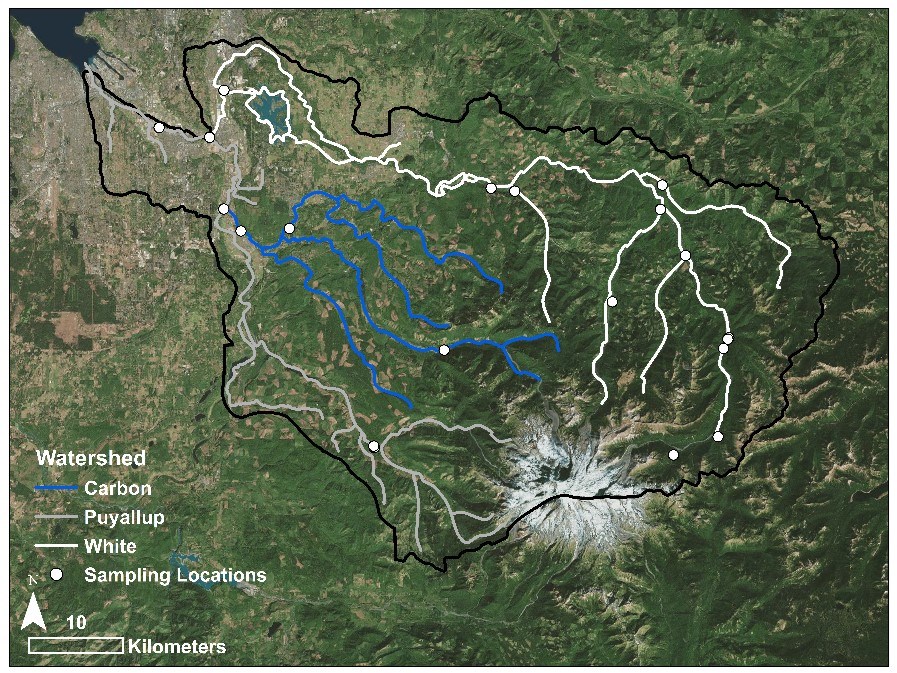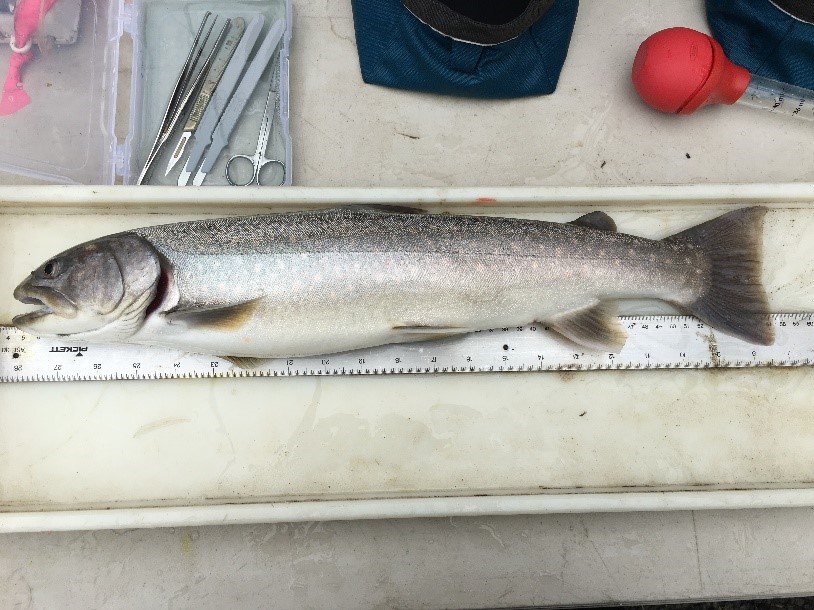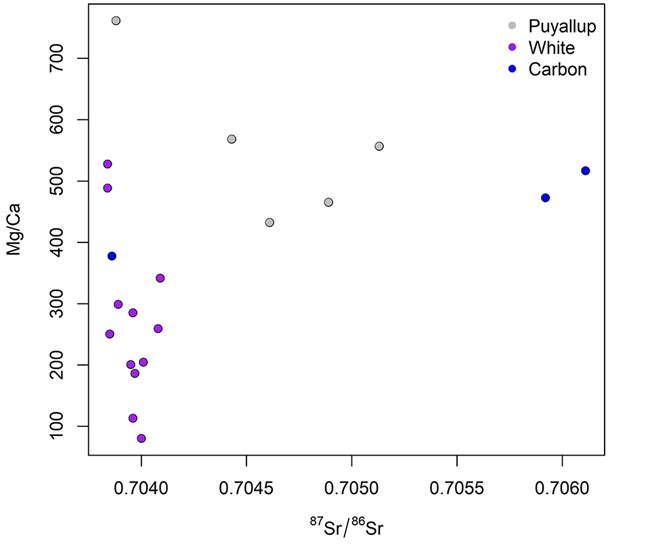Last updated: May 14, 2020
Article
Inferring Movements of Bull Trout Using Geochemical Signatures in Mount Rainier National Park

Background
Bull trout, a federally threatened species, are native to several drainages within Mount Rainier National Park, including the Puyallup River basin and many of its tributaries. The life history and migratory patterns of bull trout in the Puyallup River basin are variable and largely unknown. The best-known life history patterns are migratory forms which may display fluvial or anadromous patterns, and presumably resident forms which likely reside solely within small headwater drainages. Little information is known regarding the specific movements and habitat use of bull trout in the basin. We aim to use the natural variation in elemental and isotopic tracers of river waters and fish fin rays across the Puyallup basin to infer movement patterns among different habitats.

Strontium isotope ratios (87Sr/ 86Sr) and trace element signatures (e.g., Sr/Ca ratios) found in bony structures of fish often reflect distinct water chemistries based on differences in underlying bedrock geology, and have been used to describe the movements and life history patterns of fish. These analyses generally use fish otoliths (small ear-stones) and require lethal sampling. Lethal sampling is undesirable for a listed species, such as bull trout. To circumvent mortality, we use a nonlethal technique that extracts sections of fin rays to determine an individual fish’s geochemical signatures over the course of their life. Chemical analyses of water samples were used to determine if the values from different areas are distinct enough to be useful to assess habitat use and migratory patterns. If 87Sr/ 86Sr ratios and trace element concentrations are geographically distinct, fin ray analyses will be used to infer migratory patterns at an appropriate scale based on the results from the water samples.
Project Objectives
- Determine 87Sr/ 86Sr ratios and trace element (Sr, Mg, Zn, Mn, and Ba) concentrations in water samples collected in the Puyallup River basin.
- Determine if 87Sr/ 86Sr and trace elements can be used to assess bull trout habitat use and migratory patterns throughout the basin at a relevant scale for management.
- If appropriate (based on the above), use 87Sr/ 86Sr and trace elements to infer habitat use and migratory patterns of bull trout using fin ray microchemistry.
Management Applications
If we are able to gain a better understanding of freshwater migratory patterns of bull trout in the basin using geochemical tracers, managers can make more informed decisions regarding habitat protection and restoration. Habitat connectivity is particularly important for bull trout due to their long migrations and the variety of habitats utilized. An improved understanding of their movement patterns could be necessary for future management.
Methods
River water samples were collected from twenty locations both in and outside of the park’s boundaries in early August. Duplicate, triplicate, or quintuplicate samples were collected at each site using a syringe filtration technique. Upon collection, water samples were sent to the University of Utah’s Inductively Coupled Plasma Mass Spectrometry (ICPMS) Laboratory for analysis of 87Sr/ 86Sr ratios using a multi-collector ICPMS and concentrations of Sr, Mg, Zn, Mn, and Ba using a single-collector.

Bull trout fin rays were collected at the U.S. Army Corps of Engineers’ fish passage facility in the White River downstream of the park boundary. Fish were dip netted from the facility’s fish trap into a tank and anesthetized with tricane methanesulfonate (MS-222). The ventral portion of the second leading pectoral fin ray was extracted using a scalpel. Once the extraction was complete, fish were placed in a dip net and quickly moved to a tanker truck to be transported back into the White River upstream of Mud Mountain Dam.

Preliminary Water Chemistry Results
Preliminary water chemistry results show variation among sampling locations in 87Sr/ 86Sr and elemental concentrations of Sr, Mg, Zn, Mn, and Ba throughout the Puyallup River basin (ANOVA, α = 0.05). Specifically, 87Sr/ 86Sr ratios vary significantly between the east (White River watershed) and the west (Carbon River watershed) sides of the basin. Generally, lower 87Sr/ 86Sr ratios are found in the White River and upper Carbon River watersheds, while higher ratios are observed in the Puyallup and lower Carbon River watersheds.


Trace element data combined with 87Sr/ 86Sr ratios will be used to distinguish streams. In particular, Mg/Ca ratios show significant variation within and among the three main sub-watersheds, and in combination with 87Sr/ 86Sr will be useful to differentiate streams in the White River watershed.
Fin ray data are still being processed. Based on our preliminary water results, fin rays will likely be able to reconstruct the different freshwater migratory patterns of bull trout at a sub-watershed scale.
Contact Information
Rebecca Lofgren – Mount Rainier National Park – rebecca_a_lofgren@nps.gov
Michaela Lowe – University of Washington – mrlowe@uw.edu
Roger Peters – U.S. Fish & Wildlife Service – roger_peters@fws.gov
Ben Wright – Mount Rainier National Park – ben_wright.gov
